Plot summary
Derec and Ariel are stranded on a mysterious planet in an experimental city entirely populated by robots. Because Robot City has no spaceport, space ships or any way to radio for help, their only hope is to find the Key of Perihelion, an advanced transporting device that brought them to Robot City, and use it to transport elsewhere. While searching the city for clues, they learn that robots have taken the Key to a large building, but they cannot gain access to the building. Ariel distracts the security robot while Derec sneaks in and learns the robots have dismantled the original Key in order to produce more. Derec is caught trying to steal one of the newly manufactured Keys and is taken to the supervisor robot. However, he was still able to hide one on his person. They learn a Key only works with the being (robot, human, or alien) who has initialized it and the robots are initializing all the Keys for robots.
In searching the Central Core for other options of self-rescue, they discover there are now three other unknown beings on the planet. Through interviewing random robots near sightings, they determine two of the three are a robot and a child, who is most likely starving due to the absence of food in an all robot city. They begin using their food replicator to produce food smells in hopes to attract the hungry visitor. It also involves a First Law priority to get the robots to help them search for the other inhabitants.
The third being is Jeff, a human who is the only survivor of a passenger ship that was attempting an emergency landing on the planet. Robot City's medical robots, who have advanced medical knowledge but erroneously lack basic human anatomy knowledge, weren't able to save Jeff's body. First Law dictated they save his brain by transplanting it into a robot body, thus creating a cyborg. They then froze his body to repair it when they get the human anatomy data they need.
When Jeff wakes up and is made aware of this fact, he panics and escapes without the medical team being able to finish their tests. Jeff quickly begins displaying psychological problems such as paranoia and anger impulses. He determines he is going to take over and rule Robot City with his superior strength, due to his robot body, yet no obligation to follow the Three Laws of Robotics. The medical team organizes a citywide search for Jeff, but his outward appearance makes it easy for him to blend anonymously into the robot crowd.
While exploring the city, Jeff's robot nose smells Derec and Ariel's food and follows the smells to them. In a fit of paranoid rage, he strikes them. Other robots, unaware of the robot being a "human," see this attack as a malfunctioning robot breaking the First Law and attempt to seize him, but Jeff escapes. Derec and Ariel are then involved in the capture of Jeff for their safety. They fear Jeff is in danger due to a chemical imbalance his brains life support system which increases the city's robots priority in searching for Jeff.
Later, Jeff happens across the other pair of beings in the city - Alpha and Wolruf. As Derec and Ariel surmised, Wolruf is starving. Jeff takes sympathy on the non-human and orders a city robot to feed Wolruf, but to not to report it is doing so. Also, Jeff calls Derec and Ariel and attempts to convince Ariel that she and Derec should do the transplant as well. This strikes a chord with Ariel due to her fatal disease. Jeff escapes detection several other times, but the medical team's search net is closing in.
Jeff is finally caught and identified by his lack of a radio comlink and his failure to accurately reproduce the behavior of a robot following the Three Laws. It is confirmed a hormone imbalance due to the robot's naivety of human chemistry has caused his erratic behavior. By scanning Derec's body, the medical robots are able to repair Jeff's human body and re-transplant his brain back into it.
Because of Alpha's lack of a radio comlink, he was also singled out during the search for Jeff. This brings Alpha back in contact with Derec and Ariel, who then learn of Wolruf's presence on the planet as well. Alpha also informs Derec that during Jeff's capture, he has been renamed to Mandelbrot when his special arm, which came from a robot similar to those in Robot City, became fully functional. Alpha, now Mandelbrot, informs them that the two arrived in a small ship taken from the Rockliffe Space Station and used it to follow the radio signal left by the Key. Thus, there is a working ship they can use to escape.
They are disappointed to find the ship is a one-person escape pod. They decide Jeff is the one who should use it to leave once his body has recuperated, despite Ariel's impending mortality. By now Derec and Ariel infer they have feelings for each other, but do not discuss it. Jeff leaves Robot City promising to send a rescue team when he reaches civilization. Again, Derec and Ariel are stranded in Robot City.
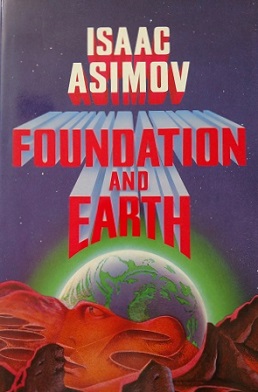
Foundation and Earth is a science fiction novel by American writer Isaac Asimov, the fifth novel of the Foundation series and chronologically the last in the series. It was published in 1986, four years after the first sequel to the Foundation trilogy, which is titled Foundation's Edge.

The Foundation series is a science fiction book series written by American author Isaac Asimov. First published as a series of short stories and novellas in 1942–50, and subsequently in three collections in 1951–53, for nearly thirty years the series was a trilogy: Foundation; Foundation and Empire; and Second Foundation. It won the one-time Hugo Award for "Best All-Time Series" in 1966. Asimov later added new volumes, with two sequels: Foundation's Edge and Foundation and Earth, and two prequels: Prelude to Foundation and Forward the Foundation.
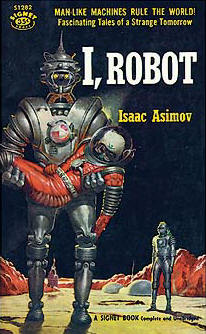
The Three Laws of Robotics are a set of rules devised by science fiction author Isaac Asimov. The rules were introduced in his 1942 short story "Runaround", although similar restrictions had been implied earlier stories. The Three Laws, supposedly from the "Handbook of Robotics, 56th Edition, 2058 A.D.", are:
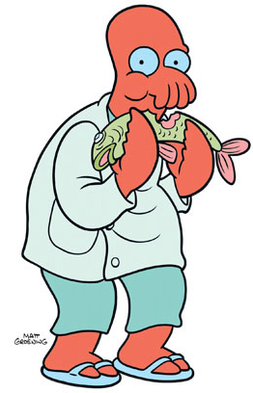
Dr. John A. Zoidberg, often referred to by his surname, is a fictional character from the animated series Futurama. He is a Decapodian, a crustacean-like species of alien, who works as the staff doctor for Planet Express, despite his woeful understanding of human physiology and allusions to his questionable credentials. His character parodies the supposed wealth and automatic respect of modern doctors—for example, his incompetence at human medicine makes him extremely poor despite his profession, and he is implied to be frequently homeless when not at work. The Decapod are an extended parody on Jewish culture —the bigger joke being that shellfish are not kosher. The writing riffs on the marine theme in a playfully absurd way, with just about any marine Arthropoda or Mollusca being implied to be akin to Zoidberg. He is voiced by Billy West, who performs the character with a Yiddish-inflected accent inspired by actors George Jessel and Lou Jacobi.
A positronic brain is a fictional technological device, originally conceived by science fiction writer Isaac Asimov. It functions as a central processing unit (CPU) for robots, and, in some unspecified way, provides them with a form of consciousness recognizable to humans. When Asimov wrote his first robot stories in 1939 and 1940, the positron was a newly discovered particle, and so the buzz word "positronic" added a scientific connotation to the concept. Asimov's 1942 short story "Runaround" elaborates his fictional Three Laws of Robotics, which are ingrained in the positronic brains of nearly all of his robots.

R. Daneel Olivaw is a fictional robot created by Isaac Asimov. The "R" initial in his name stands for "Robot," a naming convention in Asimov's future society during Earth's early period of space colonization. Daneel is introduced in The Caves of Steel, a serialized story published in Galaxy magazine vol. 7 #1-3 from October to December 1953. The full story was published by Doubleday as a hardcover book in 1954.

Foundation's Triumph (1999) is a science fiction novel by American writer David Brin, set in Isaac Asimov's Foundation universe. It is the third book of the Second Foundation trilogy, which was written after Asimov's death by three authors, authorized by the Asimov estate. Brin synthesizes dozens of Foundation-Empire-Robots novels and short stories by Isaac Asimov, Roger MacBride Allen, and authorized others into a consistent framework. Foundation's Triumph includes an appendix chronology compiled by Attila Torkos.

Norby is a fictional robot created by Janet Asimov and Isaac Asimov who stars in his own series of children's science fiction books, The Norby Chronicles. His first appearance was in the 1983 book Norby, the Mixed-Up Robot, in total he appeared in 11 novels in the 'Norby' series. According to Isaac Asimov, although Janet Asimov did 90% of the work, his "name was wanted on the book for the betterment of sales [and he] went over the manuscript and polished it a bit."

Fantastic Voyage is a 1966 American science fiction adventure film directed by Richard Fleischer and written by Harry Kleiner, based on a story by Otto Klement and Jerome Bixby. The film is about a submarine crew who is shrunk to microscopic size and venture into the body of an injured scientist to repair damage to his brain. Kleiner abandoned all but the concept of miniaturization and added a Cold War element. The film starred Stephen Boyd, Raquel Welch, Edmond O'Brien, Donald Pleasence, and Arthur Kennedy.

Lucky Starr and the Rings of Saturn is the final novel in the Lucky Starr series, six juvenile science fiction novels by Isaac Asimov that originally appeared under the pseudonym Paul French. The novel was first published by Doubleday & Company in 1958. It was the last novel to be published by Asimov until his 1966 novelization of Fantastic Voyage, and his last original novel until 1973's The Gods Themselves. Lucky Starr and the Rings of Saturn is the only novel by Asimov set in the Saturnian system.
Isaac Asimov's Robots and Aliens is a series of novels written by various authors and loosely connected to Isaac Asimov's Robot series. Each volume is complete in itself, but they form a continuing series. The series follows the action of the novels of the Isaac Asimov's Robot City series, with the same protagonists Derec and Ariel, and many other characters. The plot deals with the Three Laws and encounters between robots and different varieties of alien life.
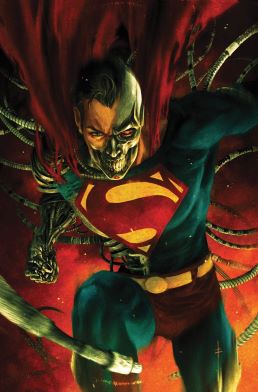
Henry "Hank" Henshaw is a supervillain appearing in American comic books published by DC Comics, and normally goes by the name Cyborg Superman. Created by writer-artist Dan Jurgens, the character originally appeared primarily as an enemy of Superman, however in recent years he has also been an enemy of the Green Lantern Corps.

Isaac Asimov's Robot City: Odyssey is a science fiction novel written in 1987 by Michael P. Kube-McDowell. It is part of the series Isaac Asimov's Robot City, inspired by Isaac Asimov's Robot series. The 1995 computer game Robot City is based on the plot of Odyssey.

Isaac Asimov's Robot City: Suspicion is a book written in 1987 by Mike McQuay. It is part of the series Isaac Asimov's Robot City, which is inspired by Isaac Asimov's Robot series.

Isaac Asimov's Robot City: Refuge is a book written in 1988 by Rob Chilson. It is part of the series Isaac Asimov's Robot City, which is based on Isaac Asimov's Robot series. It was Rob Chilson's return to writing at novel length after a break of over a decade.

Isaac Asimov's Robot City: Perihelion is a book written in 1988 by William F. Wu. It is part of the series Isaac Asimov's Robot City, which was inspired by Isaac Asimov's Robot series.
The Foundation universe is the future history of humanity's colonisation of the galaxy, spanning nearly 25,000 years, created through the gradual fusion of the Robot, Galactic Empire, and Foundation book series written by American author Isaac Asimov.
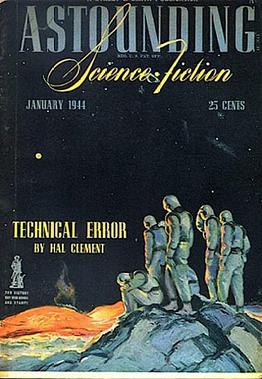
Far Centaurus is a science fiction short story by Canadian-American writer A. E. van Vogt, first published in Astounding Science Fiction in 1944. Writer and critic P. Schuyler Miller called it "unforgettable and unforgotten."

"Black Destroyer" is a science fiction short story by Canadian-American writer A. E. van Vogt, first published in Astounding SF in July 1939. It has been marked as the story that represents the start of the Golden Age of Science Fiction.















